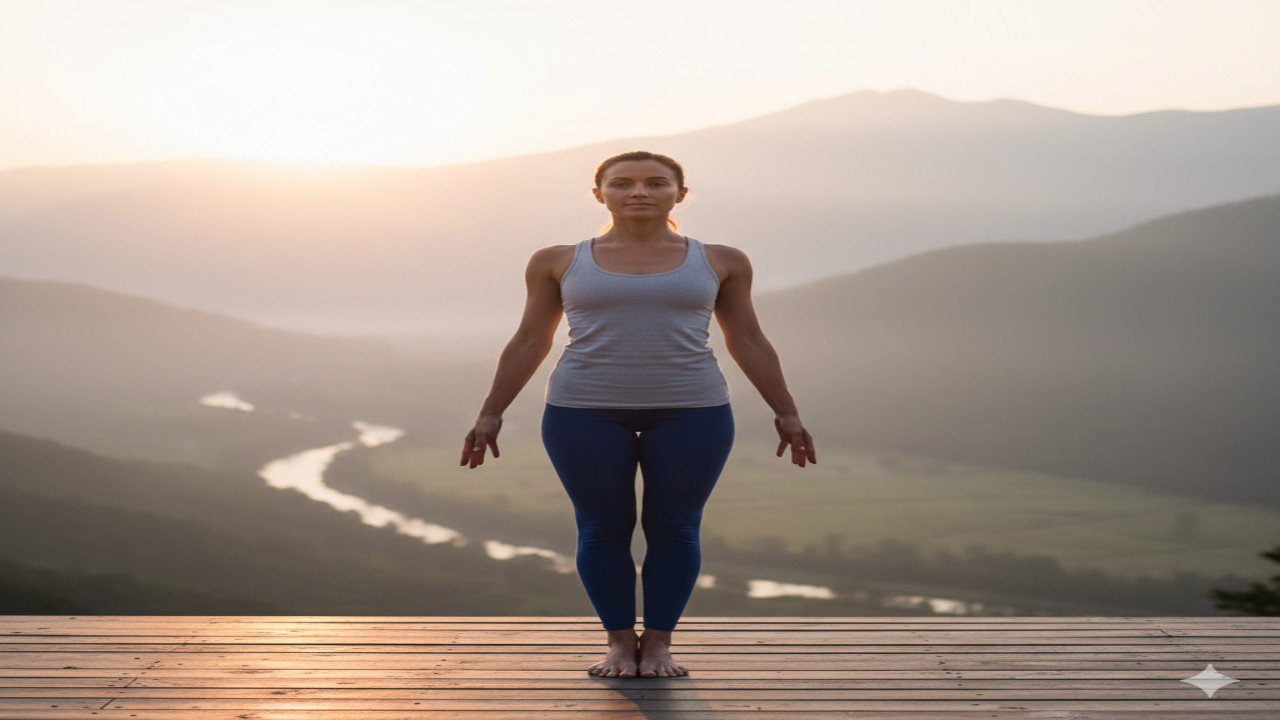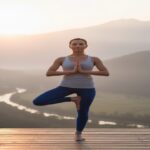In the vast landscape of yoga, some poses command attention through their complexity and dramatic appearance. Yet, there exists a pose so simple in appearance that many overlook its profound significance—Tadasana, or Mountain Pose. This foundational standing posture may look like merely standing still, but it is, in fact, the blueprint for all other standing poses and a gateway to understanding the essence of yoga itself.
Tadasana teaches us that stillness is not the absence of action, but rather the perfect balance of opposing forces. Like a mountain standing firm against the elements, this pose cultivates stability, strength, and an unwavering presence. Whether you’re a complete beginner taking your first steps into yoga or an advanced practitioner refining your practice, Tadasana offers layers of depth waiting to be discovered.
This comprehensive guide will explore every aspect of Mountain Pose, from its physical mechanics to its philosophical implications, providing you with the knowledge to transform this seemingly simple stance into a powerful practice of awareness and alignment.
What is Tadasana?
Tadasana, derived from the Sanskrit words “tada” (mountain) and “asana” (pose), is the foundational standing posture in yoga. It represents the starting point and reference position for nearly all standing poses and is often used as a transitional pose between sequences.
At first glance, Tadasana might appear to be nothing more than standing upright. However, this assessment misses the intricate dance of muscular engagement, skeletal alignment, and conscious awareness that defines true Mountain Pose. In Tadasana, the body learns to stand with optimal alignment, distributing weight evenly and engaging muscles with just the right amount of effort—not too much, not too little.
The pose embodies the qualities of a mountain: grounded, stable, majestic, and unshakeable. Just as a mountain rises from the earth with immovable presence, Tadasana teaches practitioners to root down through the feet while simultaneously lifting upward through the crown of the head, creating a dynamic equilibrium between grounding and elevation.
The Anatomy of Mountain Pose
Understanding the anatomical principles of Tadasana helps practitioners move beyond simply standing to truly inhabiting the pose with awareness and precision.
Foot Placement and Foundation
The foundation of Tadasana begins with the feet. Stand with your feet hip-width apart or with big toes touching and heels slightly separated, depending on your body structure and comfort. The feet should be parallel, with toes pointing straight ahead.
Distribute your weight evenly across four corners of each foot: the base of the big toe, the base of the little toe, the inner heel, and the outer heel. This creates a stable foundation and activates the arches of the feet. Spread your toes wide and press them gently into the floor without gripping or curling them.
Leg Engagement
Engage your leg muscles by gently lifting your kneecaps, which activates the quadriceps. However, avoid locking or hyperextending the knees. The engagement should be firm but not rigid, creating stability without tension.
Rotate your inner thighs slightly back and broaden across the sitting bones. This subtle internal rotation helps align the pelvis and creates space in the lower back.
Pelvic Alignment
The pelvis serves as the bridge between the upper and lower body. In Tadasana, the pelvis should be in a neutral position—not tilted forward (anterior tilt) or backward (posterior tilt). Imagine the pelvis as a bowl of water that should remain level.
Draw your lower abdomen gently in and up, engaging the core without creating tension. This supports the lower back and helps maintain the natural curves of the spine.
Spinal Extension
The spine should maintain its natural curves: the slight inward curve of the lumbar spine, the gentle outward curve of the thoracic spine, and the inward curve of the cervical spine. Lengthen through the entire spine, creating space between each vertebra.
Imagine a golden thread pulling the crown of your head toward the ceiling, elongating the spine without creating rigidity. This creates a sense of upward lift while maintaining the spine’s natural architecture.
Shoulder and Arm Position
Roll your shoulders up, back, and down, broadening across the collarbones. The shoulder blades should rest naturally against the back ribs without pinching together or splaying apart excessively.
Arms hang naturally alongside the body with palms facing the thighs or turned slightly forward to open the chest. Fingers are together but relaxed, pointing toward the floor with energy extending through the fingertips.
Head and Neck Alignment
The head should balance effortlessly atop the spine, neither jutting forward nor pulling back. The chin is parallel to the floor, and the gaze is soft and forward. The back of the neck is long, and the throat remains soft and open.
Relax the muscles of the face, jaw, and tongue. This facial relaxation often reflects and encourages relaxation throughout the entire body.
Step-by-Step Instructions
Getting Into Tadasana
Step 1: Establish Your Foundation Stand at the front of your mat with feet hip-width apart or together. Take a moment to feel the contact between your feet and the earth. Rock gently forward and back, then side to side, gradually reducing the movement until you find your center point of balance.
Step 2: Ground Through Your Feet Press all four corners of your feet evenly into the mat. Spread your toes wide and feel the arches of your feet lift. Imagine roots growing from your feet deep into the earth.
Step 3: Activate Your Legs Without locking your knees, engage your thigh muscles by gently lifting your kneecaps. Feel the strength in your legs while maintaining a sense of ease.
Step 4: Align Your Pelvis Draw your tailbone slightly down toward the floor while lifting your lower abdomen. Find the neutral position of your pelvis where your hip bones and pubic bone are in the same vertical plane.
Step 5: Lengthen Your Spine Grow tall through your spine, creating space between each vertebra. Maintain the natural curves of your spine without exaggerating them.
Step 6: Position Your Shoulders Roll your shoulders up toward your ears, back, and then down, creating breadth across your collarbones. Let your arms hang naturally with palms facing your thighs or turned slightly outward.
Step 7: Align Your Head Balance your head directly over your pelvis. Lengthen through the back of your neck and soften your facial muscles. Your ears should align over your shoulders.
Step 8: Breathe and Settle Take several deep breaths, making any small adjustments necessary to find comfort and stability. Soften any areas of unnecessary tension while maintaining the integrity of the pose.
The Physical Benefits of Tadasana
Improved Posture
Mountain Pose is essentially a lesson in optimal posture. Regular practice retrains the body to maintain proper alignment not just on the yoga mat, but throughout daily life. This improved posture reduces strain on muscles and joints, preventing the chronic pain often associated with poor postural habits.
Core Strength and Stability
While Tadasana may not look demanding, maintaining the pose correctly requires engagement of the deep core muscles. This subtle activation strengthens the transverse abdominis and multifidus muscles, which are crucial for spinal stability and overall core strength.
Enhanced Body Awareness
Tadasana develops proprioception—the ability to sense your body’s position in space. This heightened awareness helps prevent injuries and improves performance in all physical activities, from sports to simple daily tasks.
Balanced Muscle Development
The pose addresses muscular imbalances by teaching equal engagement on both sides of the body. Over time, this helps correct asymmetries and promotes more balanced muscle development.
Foot and Ankle Strength
The emphasis on grounding through the feet strengthens the small muscles of the feet and ankles. This creates a more stable foundation for standing and walking, potentially reducing the risk of falls and ankle injuries.
Respiratory Improvement
The open chest position in Tadasana allows for fuller, deeper breaths. The alignment of the rib cage and spine creates optimal conditions for respiratory function, increasing oxygen intake and improving lung capacity.
Nervous System Regulation
The stillness and focused awareness required in Tadasana has a calming effect on the nervous system. The pose can help reduce anxiety and promote a sense of grounding and centeredness.
Skeletal Alignment
Regular practice helps align the skeletal system, reducing wear and tear on joints. This is particularly beneficial for the spine, hips, and knees, potentially preventing or alleviating joint pain.
Mental and Emotional Benefits
Cultivating Presence
Tadasana is a meditation in stillness. The pose demands complete presence—you cannot daydream or let your mind wander without losing the precise alignment and engagement required. This training in presence naturally extends into daily life, helping practitioners become more mindful and attentive.
Building Inner Strength
Standing firmly in Mountain Pose cultivates mental resilience. The pose teaches that strength doesn’t always look dramatic or dynamic; sometimes true power lies in stillness, in the ability to remain centered and unmoved by external circumstances.
Developing Patience
Finding and maintaining the subtle adjustments in Tadasana requires patience. There are no shortcuts to proper alignment. This patience developed on the mat translates to greater patience in daily life situations.
Grounding and Stability
The emphasis on rooting down through the feet creates a sense of being grounded and connected to the earth. This grounding effect can be particularly beneficial for those who feel scattered, anxious, or overwhelmed, providing an anchor of stability.
Confidence and Self-Awareness
Standing tall in Mountain Pose naturally cultivates confidence. The lifted chest, aligned spine, and rooted stance create a physical expression of self-assurance that the mind begins to internalize. This improved posture and presence often translates to increased confidence in social and professional situations.
Stress Reduction
The meditative quality of Tadasana, combined with its focus on breath and alignment, activates the parasympathetic nervous system. This reduces cortisol levels and promotes relaxation, making the pose an effective tool for stress management.
Common Mistakes and How to Correct Them
Locking the Knees
The Mistake: Hyperextending or locking the knees creates unnecessary strain on the knee joints and prevents proper engagement of the leg muscles.
The Correction: Maintain a microbend in the knees. Engage your quadriceps by lifting the kneecaps without pushing the knees back. The legs should feel strong and active, not rigid.
Weight Distribution Issues
The Mistake: Leaning too far forward on the toes or too far back on the heels disrupts balance and proper alignment.
The Correction: Consciously distribute weight evenly across all four corners of each foot. Rock gently forward and back until you find the center point where you feel most balanced.
Arching the Lower Back
The Mistake: Excessive lumbar curve (swayback) creates compression in the lower spine and often results from an anteriorly tilted pelvis.
The Correction: Draw your tailbone down slightly and engage your lower abdominals. Imagine lengthening your lower back rather than arching it. The natural curve should be present but not exaggerated.
Tension in Shoulders
The Mistake: Hunched or raised shoulders create unnecessary tension and compromise breathing.
The Correction: Consciously roll shoulders back and down. Broaden across the collarbones and let the shoulder blades rest naturally on the back. Check periodically that shoulders haven’t crept up toward the ears.
Forward Head Posture
The Mistake: Jutting the chin forward misaligns the cervical spine and creates neck tension.
The Correction: Draw the chin slightly back so the ears align over the shoulders. Lengthen through the back of the neck. Imagine balancing a book on top of your head.
Gripping Toes
The Mistake: Curling or gripping with the toes creates unnecessary tension and prevents proper grounding.
The Correction: Spread the toes wide and press them gently into the mat without curling them. The toes should be relaxed yet engaged, creating a stable but not tense foundation.
Holding the Breath
The Mistake: Focusing intensely on alignment sometimes causes practitioners to hold their breath.
The Correction: Maintain steady, natural breathing throughout the pose. Use the breath as a gauge—if you can’t breathe easily, you’re trying too hard.
Variations and Modifications
Tadasana with Arms Raised
Inhale and raise your arms overhead, either parallel to each other or with palms touching. Keep your shoulders relaxed and away from your ears. This variation increases the sense of upward lift and provides a gentle stretch through the sides of the body.
Tadasana with Hands in Prayer
Bring your palms together at your heart center in Anjali Mudra (prayer position). This variation adds a meditative quality and helps center your awareness.
Tadasana on Tiptoes
Rise up onto the balls of your feet, lifting your heels off the ground. This challenges your balance and strengthens the muscles of the feet, ankles, and calves. Hold for several breaths before lowering down with control.
Tadasana with Arm Variations
Experiment with different arm positions: interlace fingers behind your back and lift the arms away from your body, creating a chest opener; or extend arms forward at shoulder height to engage the shoulders differently.
Tadasana Against a Wall
Stand with your back against a wall, heels about an inch away from the baseboard. This variation provides feedback about your alignment and helps identify and correct postural imbalances.
Tadasana with Block
Place a yoga block between your thighs and squeeze gently. This variation activates the inner thighs and helps practitioners understand proper leg engagement.
Tadasana with Eyes Closed
Once you’re comfortable with the pose, try closing your eyes. This removes visual reference points and deepens proprioceptive awareness, challenging your balance and focus.
Integrating Tadasana into Your Practice
As a Starting Point
Begin every standing sequence with Tadasana. Take several breaths to ground yourself, set an intention for your practice, and establish proper alignment before moving into more complex poses.
As a Reference Point
Return to Mountain Pose between standing postures. Use it as an opportunity to reset your alignment, reestablish your foundation, and check in with your body and breath.
As a Standalone Practice
Don’t underestimate the power of Tadasana as a complete practice in itself. Spend 5-10 minutes simply standing in Mountain Pose, making subtle adjustments, and deepening your awareness. This meditative approach can be profoundly centering.
In Daily Life
The principles of Tadasana extend beyond the yoga mat. Practice standing in Mountain Pose while waiting in line, standing at the bus stop, or during any moment of stillness throughout your day. This brings the benefits of yoga into everyday life.
The Deeper Philosophy of Tadasana
The Mountain Metaphor
The symbolism of the mountain in Tadasana runs deep. Mountains stand unchanging through storms, seasons, and centuries. They are rooted in the earth yet reach toward the sky. They embody strength without aggression, stability without rigidity.
When we practice Tadasana, we cultivate these mountain-like qualities within ourselves. We learn to remain steady in the face of life’s challenges, to be both grounded and aspirational, to occupy our space with quiet confidence.
The Balance of Opposites
Tadasana teaches the yogic principle of balance through opposites. We root down through our feet while lifting up through the crown. We engage muscles while maintaining ease. We remain still while staying alert and alive.
This balance of opposing forces—sthira and sukha (steadiness and ease)—is a fundamental concept in yoga philosophy. Tadasana provides a tangible, physical experience of this balance, teaching us to find equilibrium in all aspects of life.
Presence and Awareness
In a world that glorifies constant movement and multitasking, Tadasana offers a radical alternative: the power of simply standing still with complete awareness. The pose teaches that true presence is an active state, not a passive one. It requires sustained attention and conscious engagement.
This lesson in presence is perhaps Tadasana’s greatest gift. When we learn to stand fully present in Mountain Pose, we develop the capacity to bring that same quality of awareness to every moment of our lives.
Tadasana for Specific Populations
For Seniors
Tadasana is excellent for older adults, helping maintain balance, bone density, and postural integrity. Seniors may practice near a wall or chair for support and should focus on steady breathing and gentle engagement rather than perfect form.
For Office Workers
Those who spend hours at a desk benefit immensely from regular Tadasana practice. The pose counteracts the forward-rounded posture common among computer users and helps prevent back, neck, and shoulder pain.
For Athletes
Athletes can use Tadasana to improve body awareness, correct muscular imbalances, and enhance overall performance. The pose provides a neutral baseline from which to assess and address asymmetries.
For Pregnant Women
Tadasana is generally safe throughout pregnancy and helps maintain postural integrity as the body changes. Pregnant women may take a wider stance for greater stability and should avoid any variations that feel uncomfortable.
For Those with Anxiety
The grounding nature of Tadasana makes it particularly beneficial for anxiety management. The pose’s emphasis on rooting down and establishing stability can help calm racing thoughts and provide a sense of safety.
Precautions and Contraindications
While Tadasana is one of the safest yoga poses, certain conditions require attention:
- Those with low blood pressure may experience dizziness when standing still for extended periods
- People with headaches or migraines should avoid holding the pose for very long durations
- Those with severe osteoporosis should practice with care and possibly with support
- Individuals with balance disorders should practice near a wall or chair for safety
Always listen to your body and consult with a healthcare provider if you have any concerns about practicing Tadasana.
Conclusion
Tadasana stands as a testament to yoga’s profound simplicity. In a practice filled with impressive arm balances, deep backbends, and complex twists, Mountain Pose reminds us that the most powerful transformations often come from the simplest actions performed with complete awareness.
This foundational pose teaches us that how we stand reflects how we live. When we stand with intention, alignment, and awareness, we cultivate these same qualities in all areas of life. The strength we build in our legs supports not just our body but our journey. The lift through our spine mirrors our aspirations. The grounding through our feet connects us to what matters most.
Tadasana is both a beginning and a return—the starting point for every standing pose and the place we come back to for centering and renewal. It’s a pose we’ll practice throughout our entire yoga journey, each time discovering new layers of subtlety and depth.
Whether you have two minutes or twenty, whether you’re on a yoga mat or standing in line at the grocery store, Tadasana is always available as a practice of presence, a cultivation of strength, and a reminder of your capacity to stand firm in your own life.
Step into Mountain Pose. Feel your feet on the earth. Rise through your spine. Breathe deeply. And discover the extraordinary power of simply standing—truly standing—in your own authentic presence. Like a mountain, let yourself be immovable in your center, majestic in your bearing, and enduring in your strength.








